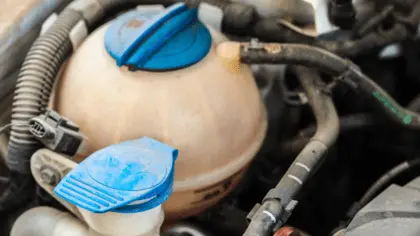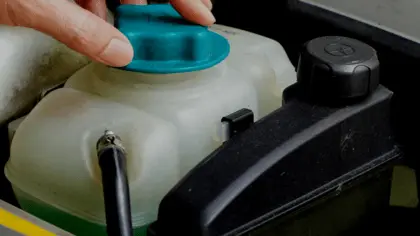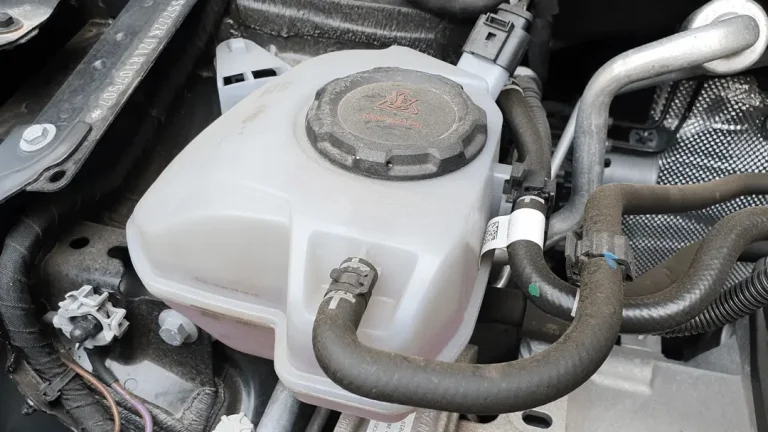A coolant reservoir is a vital component of a car’s cooling system. It holds extra coolant that is used to keep the engine from overheating. If the coolant level in the reservoir drops too low, it can cause the engine to overheat and damage the car.
The coolant reservoir is usually located near the radiator, and it is connected to the radiator by a hose. And the radiator is also connected to the engine by a hose. When the engine is running, the coolant circulates through the radiator and the engine, and then back into the reservoir.
If the coolant level in the reservoir drops too low, it can be because the radiator is not draining back into the reservoir. But if the coolant reservoir does not drain back into the radiator, your can engine can overheat and if untreated, it can give you very costly damage.
Why the Coolant Reservoir Does Not Drain Back Into the Radiator?

If your car’s coolant reservoir is not draining back into the radiator, there are a few potential reasons why. Let’s see one by one:
1. Coolant Level is Low
the most likely reason why your coolant reservoir is not draining back into the radiator is simply that the coolant level is low. If the coolant level in the radiator is low, the system will not be able to build up enough pressure to force the coolant back into the reservoir. This is why it is important to check the coolant level regularly and top it off as needed.
2. Reservoir Drain Line Blockage
The drain line can become blocked by debris or a buildup of sediment. If the reservoir is not draining properly, it is important to have it checked by a mechanic to ensure that the blockage is removed and the system is flushed.
3. Faulty Radiator Cap
Another possibility is a faulty radiator cap. The radiator cap is responsible for maintaining the proper pressure in the cooling system. If the cap is not sealing properly, coolant can leak out of the radiator and into the atmosphere. This will cause the coolant level in the radiator to drop, which will eventually lead to the engine overheating.
4. Head Gasket Leak
A coolant reservoir that is not draining properly can also be caused by a leaking head gasket. The head gasket is responsible for sealing the engine’s cylinders. If the head gasket is leaking, coolant can enter the cylinders and cause the engine to overheat.
5. Thermostat Stuck Closed
The thermostat is in charge of controlling the coolant flow through the engine. Coolant won’t be able to flow through the engine if the thermostat becomes stuck in the closed position. Instead, it will accumulate in the radiator. This can cause the radiator to overflow and the coolant to spill into the reservoir.
However, this problem is very easy to determine and does not require costly repair if treated on time. So, if you get that your car coolant reservoir is not draining back into the radiator, take action as soon as you can.
How to Diagnose and Fix the Problem?

It is important to check the coolant level regularly, especially if your car has been sitting for a while. If you notice that the coolant is low, or empty, you should check the radiator cap and hoses for leaks. If there are no leaks, and the coolant is still low, it is likely due to evaporation.
If your car has been running and the coolant reservoir is empty, the first thing you should check is the water pump and thermostat. If they are working properly, the next step is to check for head gasket leaks. This is a more serious problem and should be fixed as soon as possible to avoid engine damage.
However, if you are unsure, the best thing to do is to take your car to a mechanic for a check-up. Without proper diagnosis, you could be inadvertently causing more damage to your car.
Frequently Asked Questions
1. Does Overflow Coolant Go Back Into the Radiator?
Yes, the overflow coolant will go back into the radiator. This is because the radiator is designed to hold more coolant than the engine needs. When the engine is turned off, the coolant will settle in the radiator and the overflow will go back into the radiator.
2. Why is the Radiator Coolant Filling Up the Reservoir?
There are a few reasons why the radiator coolant may be filling up the reservoir. One possibility is that the radiator cap is not functioning properly and is not allowing the coolant to circulate properly. Another possibility is that there is a leak in the radiator system that is allowing coolant to escape.
3. Will the Radiator Pull Coolant From the Reservoir?
Yes, the radiator will pull coolant from the reservoir when the engine is running. The coolant level in the reservoir will drop as the radiator pulls coolant from it.
4. What Are the Signs That Your Water Pump is Going Out?
Some signs that your water pump may be going out include a loss of coolant, an overheating engine, or leaks in the cooling system.
5. How Do I Test if My Water Pump is Working?
There are a few ways to test if your water pump is working. One way is to feel the hoses going to and from the water pump. If the hoses are hot, then the water pump is working. Another way to test the water pump is to start the engine and let it idle for a few minutes. If the water pump is working, then the coolant level in the radiator will drop.
6. How Do You Know if Your Radiator is Clogged Up?
One way to tell if your radiator is clogged up is to look at the coolant level in the radiator. If the coolant level is low, then the radiator is not flowing properly. Another way to tell if the radiator is clogged up is to feel the radiator hoses. If the hoses are hot, then the coolant is not flowing through the radiator.
7. How Do You Unclog a Radiator System?
The best way to unclog a radiator system is to use a radiator flush. This will remove any build-up that may be causing the clog..0
The Bottom Line
A coolant reservoir that is not draining properly can cause serious problems. If the coolant level in the radiator is too low, the engine could overheat and damage the car. Lots of things could prevent a coolant reservoir from draining properly, therefore it’s important to get it checked by a mechanic to make sure the problem is fixed.


